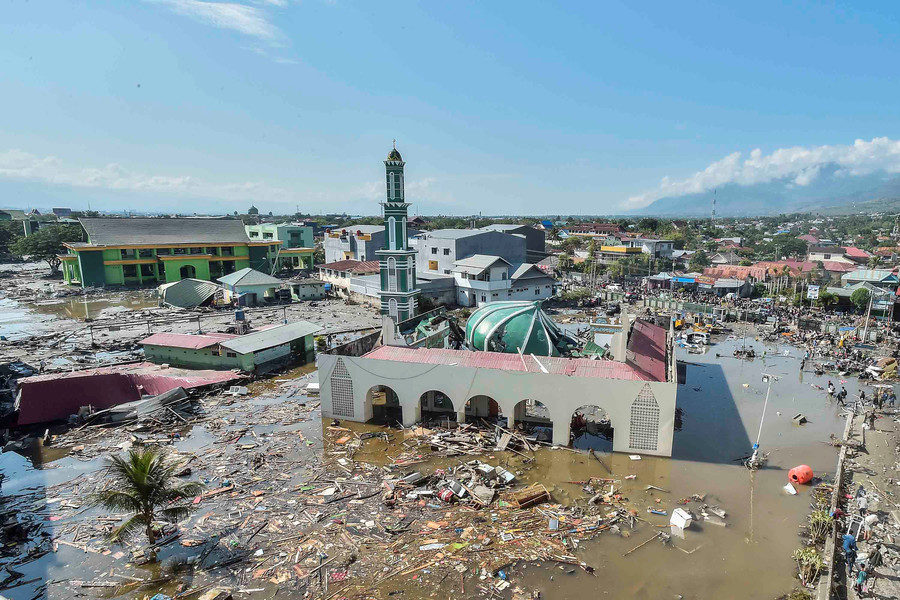
The phenomenon, known as soil liquefaction, is thought to have occurred as a result of the recent 7.5 magnitude earthquake, which also triggered a devastating tsunami. The death toll has already passed 1,200 and is expected to rise further.
Soil liquefaction can occur in saturated loose soil that is suddenly shaken - for example by an earthquake.
"When soil is saturated, the space between individual particles is completely filled with water," said Dr Stavroula Kontoe of Imperial College London. "Seismic shaking increases the water pressure between the soil particles; the particles can lose contact with each other which in turn leads to an overall loss of soil strength and stiffness."
The upshot is that, with the particles no longer bound tightly together, the soil loses its structure and behaves like a liquid.
"In very simple words, when liquefaction occurs, the strength of the soil decreases and, the ability of a soil deposit to support foundations for buildings and bridges is reduced," said Dr Carmine Galasso from University College London.
Kontoe said that certain areas are at higher risk than others from the phenomenon.
"Reclaimed land and river banks which typically consist of loose deposits are prime locations for liquefaction in case of strong shaking," she said, adding that it is unlikely that the tsunami was involved in the soil liquefaction seen in Indonesia, but rather that the earthquake was responsible.
Comment: It should be noted that many capital cities have been built on or near bodies of water.
Kontoe added that it is not only building and above-ground structures that can be affected by the phenomenon, noting there can also be damages to pipelines such as those for clean water, wastewater and gas.
The scenes from Indonesia are not the first time soil liquefaction has caused damage following an earthquake. The phenomenon is thought to have caused severe and widespread devastation in Japan after an earthquake struck in 2011. It was also blamed for contributing to the damage done by the 2011 Christchurch earthquake in New Zealand.
But Kontoe says disasters are not inevitable. "There are several mitigation techniques which can limit or even eliminate [soil liquefaction's] consequences. These techniques usually involve strengthening the soil deposits in areas where liquefaction has been identified as a major hazard and/or adopting drainage measures to prevent the increase of the water pressure during the strong shaking."
Galasso agrees there are ways to reduce risk. "Building codes and standards in many countries require engineers to consider the effects of soil liquefaction in the design of new buildings and infrastructure such as bridges, embankment dams and retaining structures," he said.



Comment: Two more videos have emerged that appear to show lateral spreads occurring during, or immediately after, the 2018 Sulawesi earthquake. These are remarkable, and truly terrifying, recordings.
The first is somewhat shaky, but remarkable for showing large structures in motion, including a transmission tower:
It seems reasonably likely that this is a lateral spread type landslide, perhaps associated with a quick clay or dynamic liquefaction process.
The second video is perhaps more clear in terms of process, and is equally dramatic. The absolute terror of those involved is obvious.
This second video captures the aftermath of the earthquake well, and in particular the stunned disbelief of those involved in the 2018 Sulawesi earthquake.
Source: Landslide Blog - Lateral spreads from the 2018 Sulawesi earthquake
The Guardian has published a second video with new footage of the tsunami hitting and the liquefaction process, including video footage of that process produced from satellite imagery:
For more on the deadly Sulawesi earthquake, tsunami and - as if that wasn't enough - the volcanic eruption that followed, see:
- Major 7.5 earthquake & devastating tsunami ravage Indonesia's Sulawesi island, Death toll reaches 832, prisoners escape - UPDATES
- Volcano erupts on Indonesia's Sulawesi days after fatal earthquake & tsunami
And for more on the increasing incidents of landslides, rockfalls and sinkholes, see: